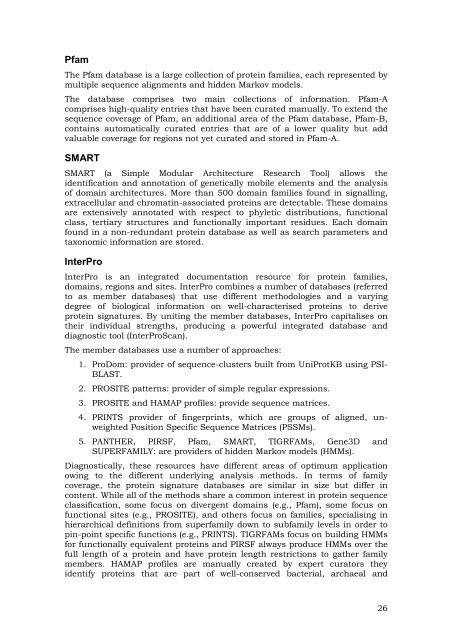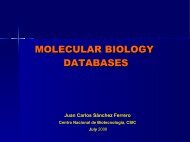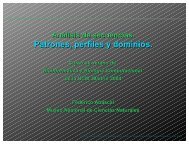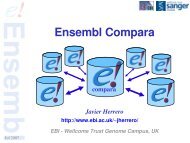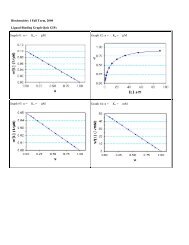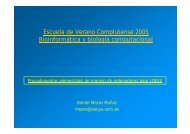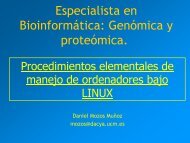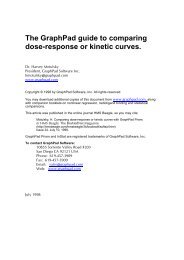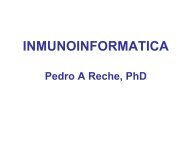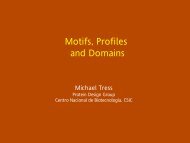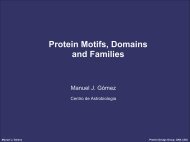Practical Course on Multiple Sequence Alignment - CNB - Protein ...
Practical Course on Multiple Sequence Alignment - CNB - Protein ...
Practical Course on Multiple Sequence Alignment - CNB - Protein ...
Create successful ePaper yourself
Turn your PDF publications into a flip-book with our unique Google optimized e-Paper software.
Pfam<br />
The Pfam database is a large collecti<strong>on</strong> of protein families, each represented by<br />
multiple sequence alignments and hidden Markov models.<br />
The database comprises two main collecti<strong>on</strong>s of informati<strong>on</strong>. Pfam-A<br />
comprises high-quality entries that have been curated manually. To extend the<br />
sequence coverage of Pfam, an additi<strong>on</strong>al area of the Pfam database, Pfam-B,<br />
c<strong>on</strong>tains automatically curated entries that are of a lower quality but add<br />
valuable coverage for regi<strong>on</strong>s not yet curated and stored in Pfam-A.<br />
SMART<br />
SMART (a Simple Modular Architecture Research Tool) allows the<br />
identificati<strong>on</strong> and annotati<strong>on</strong> of genetically mobile elements and the analysis<br />
of domain architectures. More than 500 domain families found in signalling,<br />
extracellular and chromatin-associated proteins are detectable. These domains<br />
are extensively annotated with respect to phyletic distributi<strong>on</strong>s, functi<strong>on</strong>al<br />
class, tertiary structures and functi<strong>on</strong>ally important residues. Each domain<br />
found in a n<strong>on</strong>-redundant protein database as well as search parameters and<br />
tax<strong>on</strong>omic informati<strong>on</strong> are stored.<br />
InterPro<br />
InterPro is an integrated documentati<strong>on</strong> resource for protein families,<br />
domains, regi<strong>on</strong>s and sites. InterPro combines a number of databases (referred<br />
to as member databases) that use different methodologies and a varying<br />
degree of biological informati<strong>on</strong> <strong>on</strong> well-characterised proteins to derive<br />
protein signatures. By uniting the member databases, InterPro capitalises <strong>on</strong><br />
their individual strengths, producing a powerful integrated database and<br />
diagnostic tool (InterProScan).<br />
The member databases use a number of approaches:<br />
1. ProDom: provider of sequence-clusters built from UniProtKB using PSI-<br />
BLAST.<br />
2. PROSITE patterns: provider of simple regular expressi<strong>on</strong>s.<br />
3. PROSITE and HAMAP profiles: provide sequence matrices.<br />
4. PRINTS provider of fingerprints, which are groups of aligned, unweighted<br />
Positi<strong>on</strong> Specific <strong>Sequence</strong> Matrices (PSSMs).<br />
5. PANTHER, PIRSF, Pfam, SMART, TIGRFAMs, Gene3D and<br />
SUPERFAMILY: are providers of hidden Markov models (HMMs).<br />
Diagnostically, these resources have different areas of optimum applicati<strong>on</strong><br />
owing to the different underlying analysis methods. In terms of family<br />
coverage, the protein signature databases are similar in size but differ in<br />
c<strong>on</strong>tent. While all of the methods share a comm<strong>on</strong> interest in protein sequence<br />
classificati<strong>on</strong>, some focus <strong>on</strong> divergent domains (e.g., Pfam), some focus <strong>on</strong><br />
functi<strong>on</strong>al sites (e.g., PROSITE), and others focus <strong>on</strong> families, specialising in<br />
hierarchical definiti<strong>on</strong>s from superfamily down to subfamily levels in order to<br />
pin-point specific functi<strong>on</strong>s (e.g., PRINTS). TIGRFAMs focus <strong>on</strong> building HMMs<br />
for functi<strong>on</strong>ally equivalent proteins and PIRSF always produce HMMs over the<br />
full length of a protein and have protein length restricti<strong>on</strong>s to gather family<br />
members. HAMAP profiles are manually created by expert curators they<br />
identify proteins that are part of well-c<strong>on</strong>served bacterial, archaeal and<br />
26


